MVP in Software Development: In-depth Guide
February 04, 2022 • 1176 Views • 21 min read
Bohdan Vasylkiv
CEO & Co-Founder
Perhaps, the roaring 20s are going to become a must-have part of each century. There is no need to explain what happened in the 1920s when the whole financial and economic system collapsed and significantly impacted the overall level of life.
Nowadays, the market crash seems a very realistic scenario. The world is going crazy and the number of different significant events is extremely high. This is also the ideal time for MVP in software development. Some organizations like International Monetary Fund, are being optimistic, as can be seen in their recent World Economic Outlook.
MVP development for startups is one of the main ways to avoid risks in the IT industry. So, what does MVP mean, and how to develop startup MVP?
What Does MVP Mean in Software Development?

Minimum Viable Product, also known as MVP, is a simple, ready-to-launch version of a product that includes only the most essential elements (which define its value proposition).
To rephrase it, while regular applications propose a full-fledged functionality and various additional features, MVP startups are similar to mobile app beta testing, including only the most essential services and core features for an app or service to keep existing.

MVP startup is designed to reduce time for market research, attract early adopters, and achieve product-market fit from the start. It is a “bare-bones” version of a software product, created to the test in the market.
MVP software development method allows business owners to test their assumptions and learn how the target audience responds to the main features of the product. It also helps to maximize outcomes from the minimum resources.
MVP development for startups is a constant process of identifying user demands and picking proper product features to meet user expectations over time. MVP in software development is viewed as an experiment. Instead of implementing an isolated business strategy, new firms benefit from MVP development for startups, getting insights about other business possibilities.
Pros And Cons of MVP Startups
Frankly speaking, there is a lot to say about MVP in software development and the benefits it can bring. Therefore, let’s define the most essential benefits and drawbacks of adopting MVP for startups.
Advantages of MVP Startups
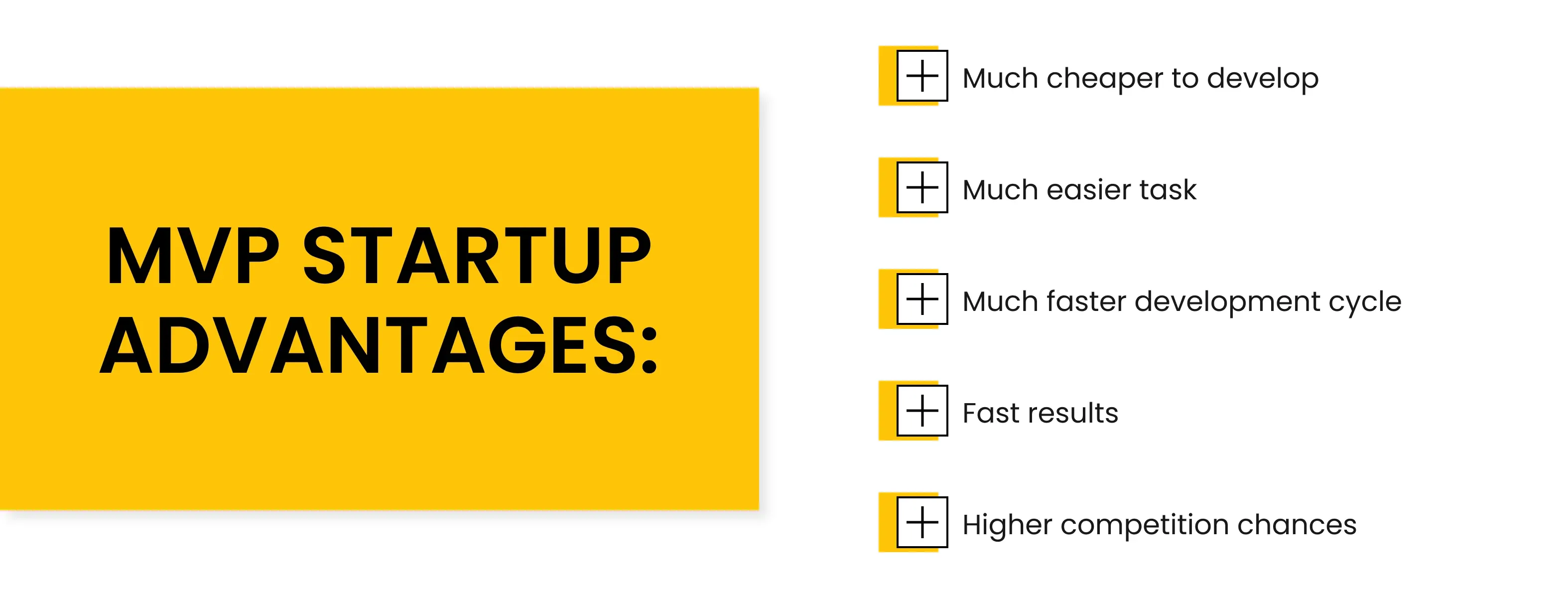
Some of the advantages of this list were briefly mentioned before.
-
Startup MVP development costs much cheaper, compared with the development of a complete full-fledged application. In case you are limited in your resources, you can develop an MVP version and then gradually integrate new features and extend the functionality of your application. Moreover, it allows gaining your target audience and improve the application, according to the potential user feedback.
-
MVP software development as a service is a much faster solution in terms of development from scratch. So, if you are targeting a new market and want to be the first one to deliver services, or you simply have a limited time for development, then MVP software development might be a great choice for your startup project.
-
Finally, MVP development for a startup is a much easier task, than other alternatives. So, even an inexperienced dedicated software development team can deal with such type of project, if they have a clear understanding of the requirements. Additionally, it gives a great possibility to outsource MVP startup development.
If you decided to choose an MVP development approach for a successful startup, then, most likely, it will be easier for you to find potential investors, due to the fact, that the cost of such apps is lower, compared to all other types of applications, as well as the level of risk is extremely low.
So, hiring developers for startups is a great advantage, because business owners have more options to choose from. You can consider hiring app developers with different experiences, and potentially change teams at different stages of startup MVP development.
Challenges of Startup MVP Development
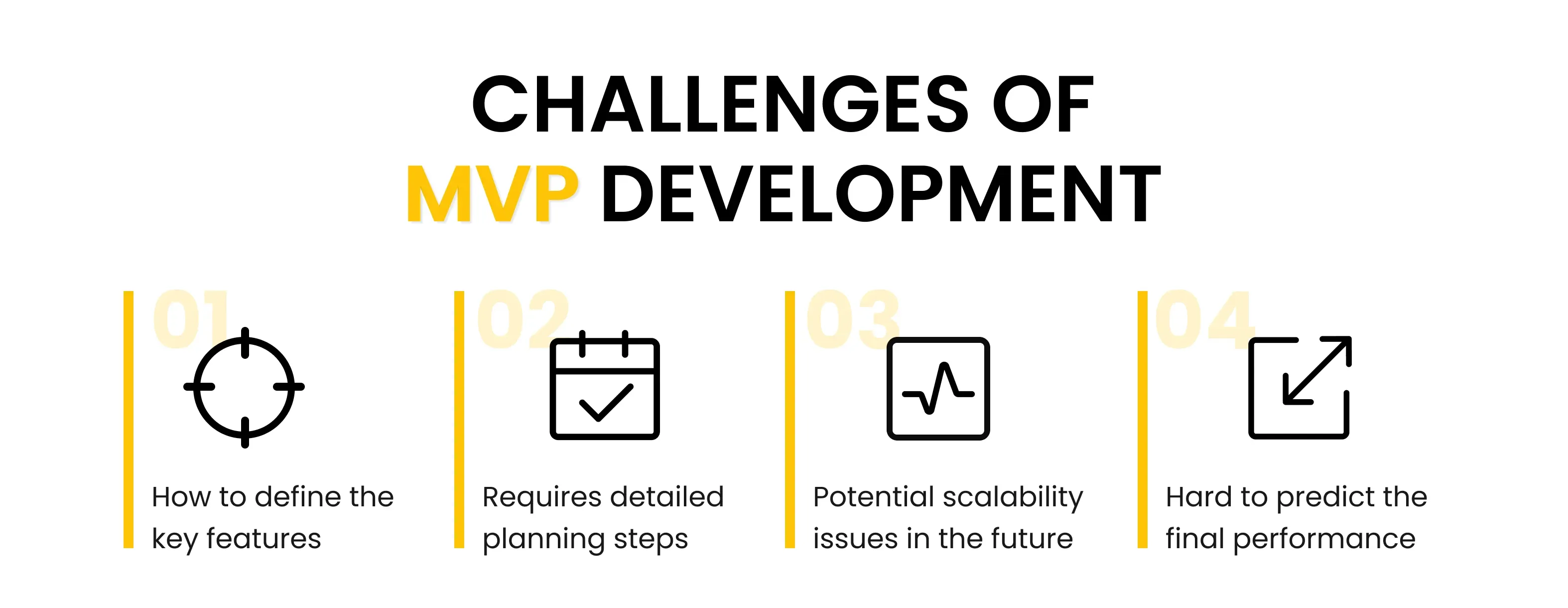
Despite all the benefits of the MVP development approach, there are some drawbacks as well.
MVP startup is still a full-fledged application with essential functionality, even if it lacks some extra useful features. It was designed to perform specific tasks under any conditions. Therefore, we prefer to use the term “challenges” instead of “drawbacks”, when it comes to imperfections of software development as a service.
One of the most problematic challenges of MVP software development is to define the key features. When we talk about these key functionalities, we mean a few specific features, that correspond with the business logic of the future product. To rephrase, these are minimum features, designed to provide particular services, that make an app useful.
To cut a long story short, MVP startup development requires detailed planning steps, when the developers have to define the most important features to be included in MVP for startup. Additionally, it is worth making a list of other features to add later. It helps to prevent the next critical challenge - scalability.
Indeed, the MVP software development as a service shouldn’t cause any issues. Still, the most common mistake during MVP development for startups - is choosing the wrong tech stack.
For instance, developers regularly aim to choose the most suited and convenient software solutions for MVP startups, which will allow the creation of efficient and simple software products, forgetting about the possible scalability possibilities.
Inexperienced software developers can use programming languages or frameworks, suited for simple and small applications. Yet, if the project succeeds and the startup owners decide to scale the app and develop new features - issues may appear. So, the whole application should be redesigned and transferred to other technologies.
Additionally, the tech stack, designed for simple applications makes it harder to predict the performance of the same app after scaling.
Frankly, probably any article about MVP in software development says about saving costs and cutting expenses during the development process. In most cases, it is a general conception with no further arguments. So, how much does it cost to develop an app, and how cheap is a startup MVP?
How Much Does It Cost To Create An App On A Global Scale?
The average price offered by the development companies in different regions per hour differs like this:
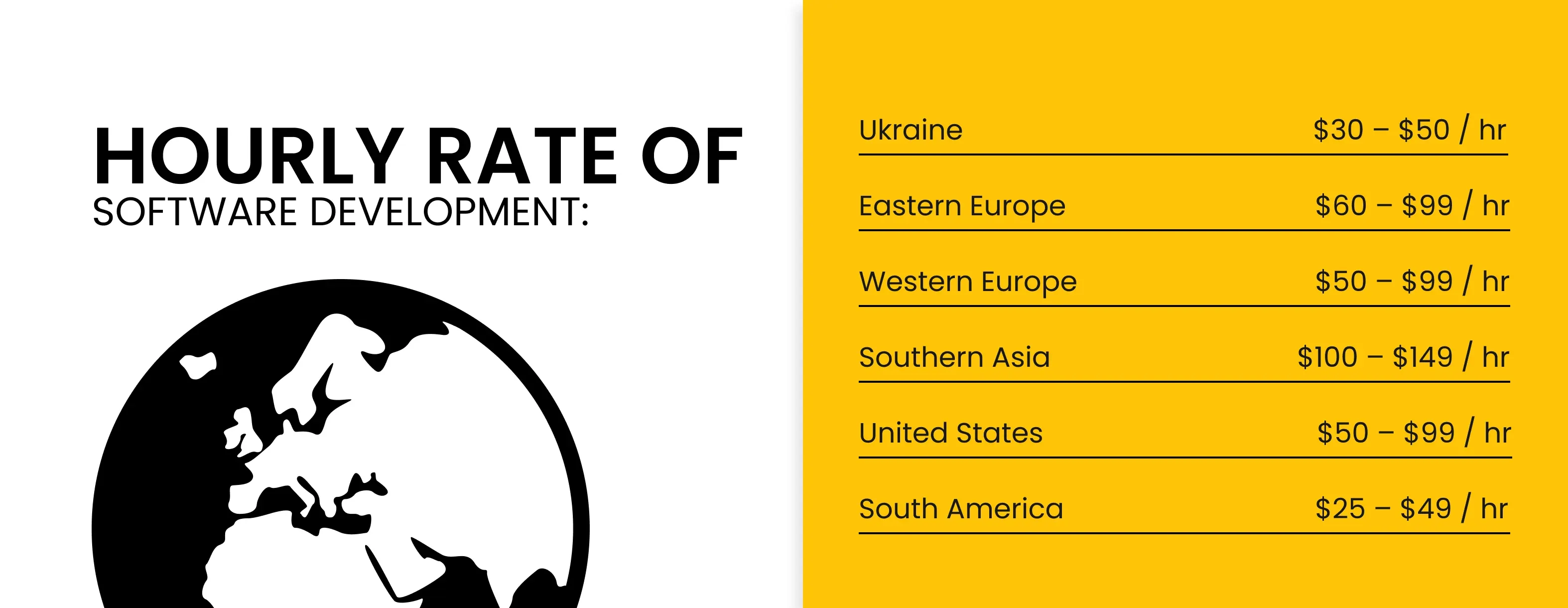
It also takes some time to develop an app. So, we have to estimate the time, required for the development of all desired features and multiply it by hourly rate. As a result, we will get an approximate cost of the development. Yet, we also have to add the price of various third-party software solutions, used during the development.
For example, let’s take an eCommerce marketplace estimation with a basic set of features:
Using that estimation, you can calculate how long it will take to create a delivery app with its features, an eLearning app with its set of functionalities, or any other software for different industries, since the table above includes the components needed for any app, like registration or security.
In total, marketplace app development would take 1212 hours. To count the development cost amount, you just need to decide on how many team members for which hourly rate you will employ, and add the cost of third-party software.
What are the MVP Development Costs?
There are always methods to reduce the overall cost of producing an app:
-
Hire a dedicated software development team. As you can see, the hourly rate can be lower in some regions, so you can consider employing a team of experts abroad. For instance, you can consider hiring developers from Eastern Europe for startups.
-
Choose MVP development for startup. Instead of creating a full-fledged application, start with the most essential features. Gather the feedback, and add the features, required by the target audience.
MVP development for startup is ideal. This software development method was designed specifically to embody the concept cheaply. While the development prices are the same as standard development, MVP software development takes less time. As a result, you will get a working app faster and cheaper.
To simplify it, MVP startup development can help cut costs at least by half. For instance, if average application development takes 4-7 months, MVP development for a startup can be done in 2-3 months. Frankly, it highly depends on the number of features to implement and the overall complexity of the project. Still, MVP startups are faster and easier in most cases, i.e. they are also cheaper.
The average price for MVP startup development also varies between 15,000 and 100,000$, depending on numerous factors. Another advantage of MVP development is the fact, that it can be done with a smaller software development team.
Step-by-Step MVP Software Development Guide
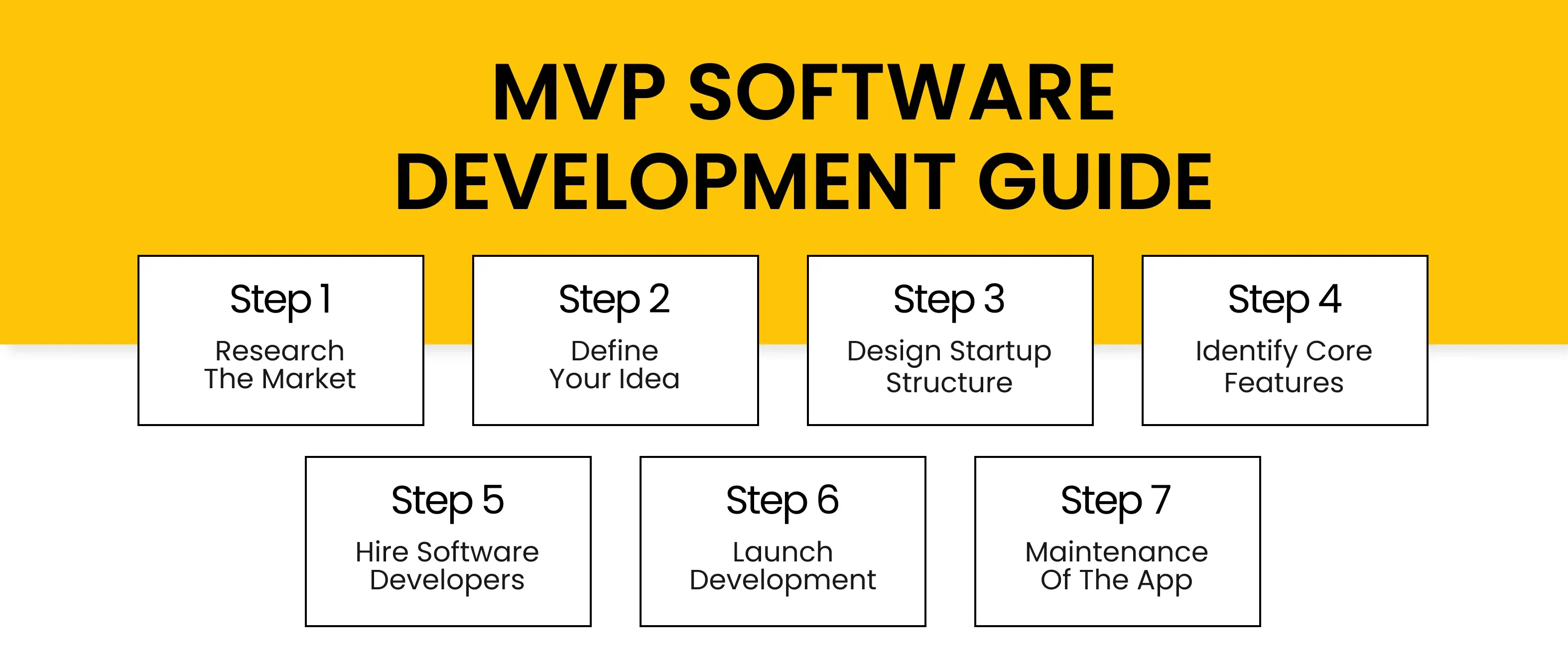
Step 1: Discovery Phase of Project
Before the MVP development process, make sure it meets the demands of the target audience. To do so, you can use surveys, market research, and field analytics.
The more you know - the better your chances of succeeding.
Also, remember to keep an eye on your rivals and their product. This can help you to identify their strengths and weaknesses. As a result, you will get a chance to cover empty market niches.
Step 2: Define the Startup Development Idea
After market research, you can specify your offer, which will fulfill the demand of your target audience.
At this startup stage, you should pay attention to all the alternatives on the market. When you have already made the decision – start hiring developers for startup. Check if the team complies with your overall vision and will be able to keep up with your plans.
Step 3: Design a Structure of Startup
The UI/UX principles should be the driving force behind app design. Select the most efficient and cost-effective method of delivering the major functions and features to the customer.
Think about how users will use the service and where they will pay for it. It might be easier for you to gather all the ideas you will have in your mind. This way you will have a more explicit understanding of how the product will scale in the future.
Step 4: Confine to the Basics
At this startup development stage, you can tell what features to include in your MVP development for the startup and what not to add, at least at the moment.
Identifying and prioritizing features may be as simple as asking yourself, “What does my user desire vs. what does my user need?” Keep in mind that integrating too many user-requested features too quickly might detract from the product’s core goal and impact the user experience. The only features you should offer must be related to the ultimate purpose of your product.
Step 5: Launch an MVP Software Development
The white-label app development may be started once the company has agreed on the major features and learned market demands.
Keep in mind that the startup MVP approach is not a lower-quality version of the final product; it must still meet the demands of the consumer.
MVP for startups must be simple to use, appealing, and relevant for the consumers. The MVP software development is the most time-consuming of the startup stages. Make use of the preferred prototype and stay on track with the objectives.
Step 6: Post-Launch Actions
You must get feedback from your users once you have launched your MVP startup.
This will help you generate new ideas, depending on consumer behavior research. It’s critical to keep learning, measuring, and testing your startup repeatedly until the product development is complete.
For a better illustration, let’s examine some successful examples of MVP startup development, and how it scaled to full-fledged applications, popular worldwide.
Successful Examples of Startup MVP
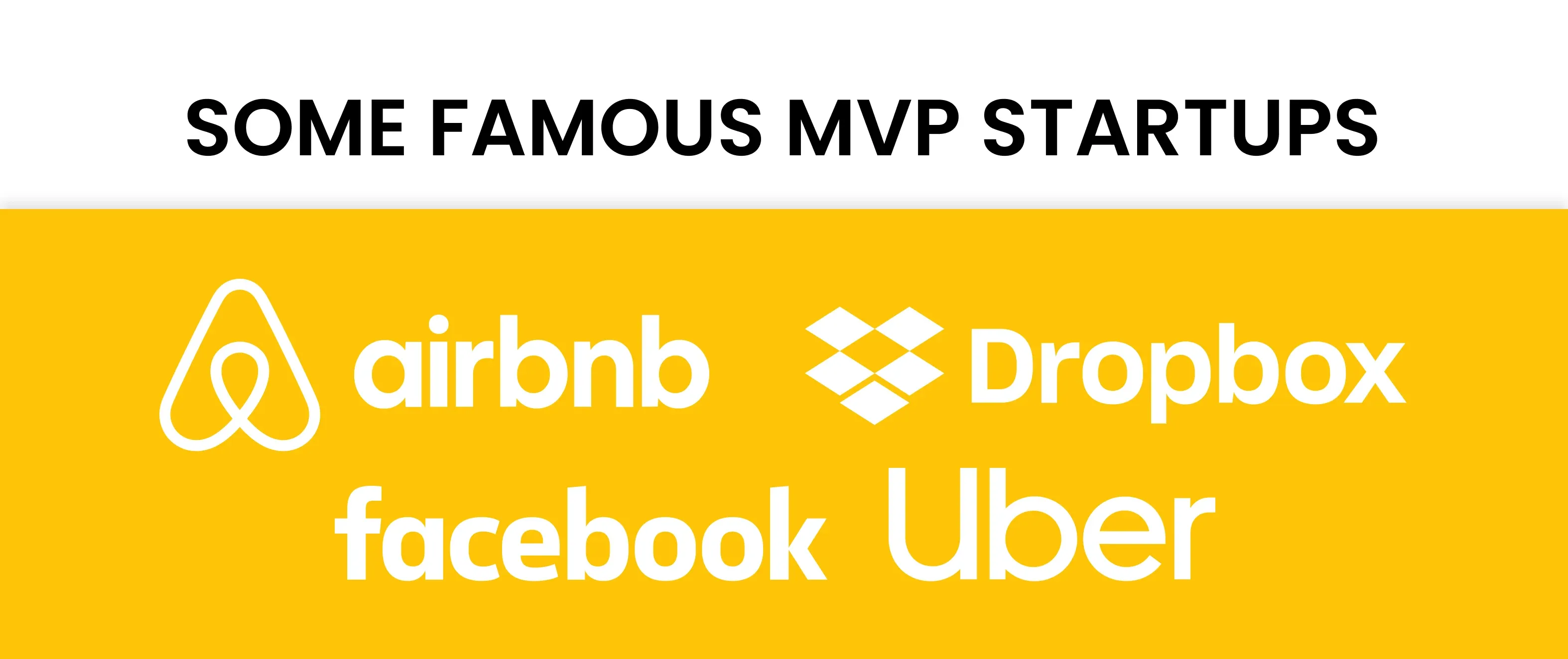
Facebook MVP
Facebook began as a simple social media platform for connecting with friends when it was first released. When Facebook went live in 2004, it was exclusively available to Harvard students, and their profiles were as simple as they could be. The concept proved to be successful enough to warrant further app development, and the platform grew over time.
Facebook was progressively pushed out to other universities in the United States, and then to the rest of the world. This aided the notion in gaining momentum and scaling effectively until it became the main modern social network with numerous branches and services.
Dropbox
Dropbox played outside the rules and opted not to start any product development at all. It started as a demo video, demonstrating the benefits of keeping data in one storage.
Startup owners wanted to see if people were interested in their file-syncing concept. They had an opportunity to create an entire hardware infrastructure, including full-fledged app development and so on, but they didn’t want to take that risk. As a result, customer input assisted the startup MVP development in obtaining the resources, needed to expand the service.
Airbnb
Airbnb provided users with the opportunity to advertise a room for short-term rental to make additional money, starting with the founders’ flat.
The platform expanded as it became obvious that tourists were ready to stay in someone else’s house to save money on lodging. So the improved features and the functionality of the platform appeared based on the first income, and founders profited with their MVP startup.
Uber
The initial concept was to match drivers with potential passengers.
When it first launched in 2009, the MVP app “UberCab” was available only for iPhone users or through SMS. Also, it was available only in San Francisco for drivers who weren’t afraid to have credit card payments authorized in an unknown app.
This was enough to achieve their main purpose of providing taxi services at a low cost. Uber as we know it now is the consequence of a successful startup MVP test and the appropriate strategy for business scalability. The app’s data helped Uber expand and quickly become one of Silicon Valley’s most valuable firms.
White Label MVP Development With Incora
It is an undeniable fact, that the minimum viable products, as well as their owners and investors, have much more chances to avoid or minimize their potential losses.
It is also clear, that MVP startups have fewer financial risks, compared to developing a complete application from scratch. They take less development time, cost less than the alternatives, and are much easier and cheaper when it comes not only to software development but maintenance as well.
It is hard to overestimate the relevance of such applications even generally, not to mention various niche specifics. For instance, among the top MVP startup examples, we can name Amazon, Dropbox, Instagram, and Facebook.
Therefore, if you are interested and looking for the possibility of hiring developers for a startup - we recommend you check some of our case studies, which also include other MVP startup examples.
Here at Incora, we have several niche-experienced developers, familiar with MVP software development, who are eager to start working on your project and can help to embody any of your startup ideas. All you need to do - is to contact us, and we will do the rest.
What’s your impression after reading this?
Love it!
1
Valuable
1
Exciting
1
Unsatisfied
1
FAQ
Let us address your doubts and clarify key points from the article for better understanding.
What is MVP in software development?
MVP stands for Minimum Viable Product. It is a version of a product with the minimum features required to satisfy early customers and provide feedback for future development. MVPs are designed to test the product concept and gather insights while minimizing development costs and time.
Why is an MVP important?
Validate Ideas: MVPs allow entrepreneurs and product teams to validate their ideas and assumptions before investing significant resources into full-scale development.
Minimize Risk: By launching an MVP, you can reduce the risk of building a product that doesn't meet market needs or preferences.
Iterative Improvement: MVPs enable iterative development based on real-world feedback, leading to a better final product.
How do I decide what features to include in an MVP?
Identify Core Features: Determine the core features that are essential for solving the primary problem or addressing the main need of your target audience.
Prioritize Features: Prioritize features based on their importance to the user experience and value proposition. Focus on what is necessary to deliver value quickly.
Start Small: Start with a minimal set of features that can demonstrate the product's value proposition and functionality.
How do I build an MVP?
Define Goals and Objectives: Clearly define the goals and objectives of your MVP, including the problem it solves and the target audience. ** Design User Flows**: Create user flows and wireframes to map out the user journey and interactions with the product.
Develop Core Features: Build the minimum set of features required to create a functional prototype of your product.
Test and Iterate: Launch the MVP to a small group of users and gather feedback. Use this feedback to iterate and improve the product in subsequent versions.
Scale Gradually: As you receive validation and positive feedback, gradually scale up the features and functionality of the product based on user needs and market demand.
What are the key principles of building an MVP?
Simplicity: Keep the MVP simple and focused on solving one core problem or addressing one main need.
Speed: Aim for quick development and deployment to gather feedback and iterate rapidly.
Learning: Treat the MVP as a learning opportunity, gathering insights and data to inform future development decisions.
Feedback: Actively seek feedback from users and stakeholders to refine and improve the product.
How do I know when to transition from an MVP to a full product?
Market Validation: If the MVP receives positive feedback and validation from users, it may be time to invest in further development to build a full-fledged product.
Growing Demand: If there is growing demand for the MVP and an increasing number of users are adopting and using it regularly, it could indicate readiness for expansion.
Iterative Improvement: If you've iterated on the MVP based on feedback and the product has evolved to meet user needs more comprehensively, it may be time to transition to a full product.
How can I keep costs low while building an MVP?
Focus on Core Features: Prioritize the development of essential features that address the primary problem or need of your target audience. Avoid adding unnecessary bells and whistles that can inflate development costs.
Use Off-the-Shelf Solutions: Utilize existing tools, frameworks, and platforms to speed up development and reduce costs. Look for open-source software or third-party APIs that can provide functionality without the need for custom development.
Iterative Development: Adopt an iterative approach to development, releasing small updates and improvements based on user feedback. This allows you to manage costs more effectively and allocate resources efficiently.
you may also like
Let’s talk!
This site uses cookies to improve your user experience. Read our Privacy Policy
Accept
Share this article